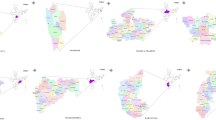Abstract
A farmers’ participatory survey was carried out in five different agroecosystems of Bangladesh to obtain information on the genetic diversity, consumers preferences for fruit quality and to assess the data to select potentially superior genotypes of jackfruit (Artocarpus heterophyllus Lam.). A wide variation in morpho-agronomic characters was identified from farmers’ information and also from laboratory analyses. Multivariate analysis of the data produced four discrete groups, represented by trees from different agroecological zones and soil types. Characteristics such as weight; length; diameter; girth of fruits; number of bulbs per fruit; percentage of pulp; percentage of rachis (core); and percentage of rind (peel) were found to be poorly correlated with environmental factors indicating that these characters may be genetically controlled. Other characters, such as seed weight, bulb weight, and brix (%) were found to be affected by environmental and genetic factors. Isozyme analysis of 50 accessions confirmed results obtained from field studies of morpho-agronomic characters. Ten potentially superior types were selected on the basis of yield, fruiting season, flesh colour, texture, sweetness, and farmers’ preference for recommendation to producers.




Similar content being viewed by others
References
Annon (1995) Ministry of Planning, Government of the Peoples Republic of Bangladesh. Bangladesh Bureau of Statistics, Statistics Division, Statistical Year Book of Bangladesh. pp 1–17
Anthony K, de Groot P, Haq N (eds) (1993) Underutilised Fruits and Nuts in Asia. Proceedings of workshop held in Dhaka, Bangladesh, CSC. pp 7–18
Arora RK (1998) Genetic resources of native tropical fruits in Asia: diversity, distribution and IPGRI’s emphasis on the conservation and use. In: Arora RK, Rao VR (eds) Tropical fruits in asia-diversity, maintenance, conservation and use. International Plant Genetic Resource Institute (IPGRI) Office, South Asia New Delhi, pp 42–53
Bashar MA, Hossain AKMA (1993) Present status of jackfruit in Bangladesh. A paper submitted to the International Centre for Underutilized Crops (ICUC), Southampton University. pp 1–21
Darlington CD, Wylie AP (1956) Chromosome atlas of flowering plants. George Allen and Unwin Ltd, London, pp 184
Dhar M (1998) Techniques of vegetative and in vitro propagation of jackfruit. Ph.D. Thesis, Institute of Postgraduate Studies in Agriculture, Salna, Gazipur, Bangladesh
Franzel S, Hitimana L, Akeyampong E (1995) Framers participation in on-station tree species selection for agro-forestry: a case study from Burundi. Exp Agr 31:27–38
Gunasena HPM, Ariyadasa KP, Wikramasinghe A, Herath HMW, Wikramasinghe P, Rajakaruna SB (1996) Manual of jack cultivation in Sri Lanka. Forest Information Service, Forest Department, pp 48
Hossain AKMA (1996) Status report on genetic resources of jackfruit in Bangladesh. IPGRI Regional Office, Singapore, pp 30
Holtzhausen LC, Grundlingh JA, Niven PNF, Maritz J (1988) Nine rootstocks evaluated for four Naval cultivars in the Eastern Cape. In: Goren R, Mendel K (eds) Proceedings of Sixth International Citrus Congress, Tel Aviv, Israel, March. pp 6–11
Islam MA (1996) Chemotaxonomy of persimmon (Diospyros kakai L.) by enzyme polymorphism and inorganic elements. A thesis submitted to The United Graduate School of Agriculture Sciences, Iwate University, Japan, pp 31
Kanzaki S, Yonemori K, Sugiura A, Subhadrabandhu S (1997) Phylogenetic relationship between jackfruit, the breadfruit and nine other Artocarpus spp. from RFLP analysis of an amplified region of cpDNA. Sci Hortic 70:57–66
Manjunath BL (1948) Wealth of India, vol 1. CSIR Publication, New Delhi, pp 1–210
Morton JF (1987) Jackfruit. In: Fruits of warm climates. Miami Florida. pp 58–64
Mouemer AAL, Gasquez J (1983) Environmental conditions and isozyme polymorphism in Chenopodium album L. Weed Res 23:141–149
Narasimham P (1990) Breadfruit and Jackfruit. In: Nagy S, Shaw PE, Wardowski WF (eds) Fruits of tropical and subtropical origin- composition, properties and uses. Florida Science Source, Inc, pp 216–259
Purseglove P (1968) Tropical crops, vol 2. Dicotyledons, Artocarpus heterophyllus-Jackfruit, vol 2. Longman, London, pp 384–386
Rowe-Dutton P (1985) Artocarpus heterophyllus-Jackfruit. In: Garner JR, Chaudhury SA (eds) The propagation of tropical fruit trees. FAO, CAB, London, pp 269–290
Ruehle GD (1967) Miscellaneous tropical and subtropical Florida fruits. Agric., Extension Survey, IFAS, University of Florida, Bull, pp 156a
Saha MC, Saha MG, Rahman MA, Nazrul MI, Quasem A, Halder NK, Hoque AFME (1996) Variability in jackfruit. A paper presented at the Internal Research Review Workshop, Horticulture Research Centre, BARI, Gazipur, Bangladesh. pp 1–4
Schnell RJ, Olano CT, Campbell RJ, Brown JS (2001) AFLP analysis of genetic diversity within jackfruit germplasm collection. Sci Hortic 91(3–4):261–274
Singh A (1986) Fruit physiology and production. Kalyani Publishers, New Delhi, pp 1–240
Soepadmo E (1991) Artocarpus heterophyllus Lam. In: Verheij EWM, Coronel RE (eds) Plant resources in South East Asia, No 2. Edible Fruits and Nuts PROSEA, Netherlands Wageningen, pp 86–91
Vinning G, Moody T (1997) A Market Compendium of Tropical Fruit. RIRDC Research Report No. 97/74, Rural Industries Research and Development Corporation, Barton, pp 110–120
Wenden JF, Weeden NF (1989) Visualization and interpretation of plant Isozymes. In: Soltis DE, Soltis PS (eds) Isozymes in Plant Biology. Chapman and Hall, London, pp 5–45
Acknowledgements
We thank the Department for International Development (DFID), UK for funding this research (R6389). However, DFID cannot accept responsibility for information provided or views expressed. We are also indebted to the Bangladesh Agricultural Research Institute BARI) for providing support for field study. We also thank Professor Trevor Williams for his useful comments on the manuscript
Author information
Authors and Affiliations
Corresponding author
Rights and permissions
About this article
Cite this article
Azad, A.K., Jones, J.G. & Haq, N. Assessing morphological and isozyme variation of jackfruit (Artocarpus heterophyllus Lam.) in Bangladesh. Agroforest Syst 71, 109–125 (2007). https://doi.org/10.1007/s10457-007-9039-8
Received:
Accepted:
Published:
Issue Date:
DOI: https://doi.org/10.1007/s10457-007-9039-8




